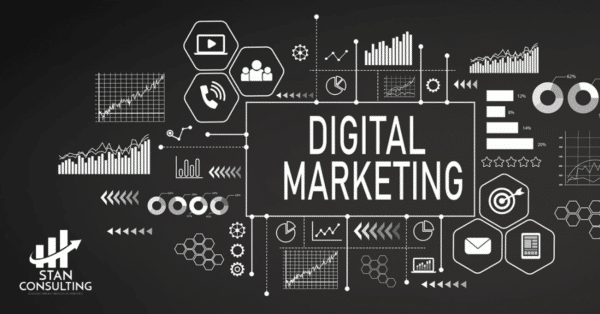
Blog

Digital Marketing Strategies: How to Drive Traffic and Boost Sales without SEO
As a seasoned marketer at Stan Consulting, I’ve witnessed firsthand the transformative power of digital marketing. Today, I’ll share a step-by-step guide on how to drive traffic to your business website and increase your sales without delving into SEO. Here’s the ultimate turn-key solution for your business.

Step 1: Develop a User-Friendly Website
A user-friendly website isn’t merely a visually appealing platform; it’s the first impression you make on your potential customers, a silent salesman and a significant element of your brand’s digital identity. Here’s how to craft an engaging and user-friendly website:
1. Simple and Intuitive Navigation: Keep your website layout straightforward. Make sure all main categories and subcategories are easy to find and navigate. Users should not struggle to find the information they need. A rule of thumb is that any important page should be accessible within 3 clicks from the homepage.
2. Readable Content: Ensure your text is easily readable. Opt for fonts that are not only stylish but also legible across different devices. Break up long blocks of text with headers, bullet points, and infographics. Use colors that contrast well, making sure the text stands out against the background.
3. Mobile Responsiveness: With more and more users browsing on their phones, your website should look and work well on any device. Mobile responsiveness is no longer a nice-to-have, but a must-have feature.
4. Fast Loading Times: Web users are impatient. If your website takes too long to load, visitors will quickly abandon it. Aim for a loading speed of 2-3 seconds or less. Compress images and use a good hosting service to improve your website’s speed.
5. Clear Calls-to-Action: Guide your visitors through the buying journey with clear calls to action. Whether you want them to make a purchase, fill out a form, or subscribe to your newsletter, make sure these actions are straightforward and visible.
6. Consistent Design: Your website should align with your brand in terms of color, typography, and style. Keep the design consistent across all pages to maintain professionalism and cohesiveness.
7. Provide Contact Information: Make it easy for users to reach out. Include multiple contact methods like phone, email, and a contact form. Consider live chat or chatbots for real-time assistance.
What to Avoid:
1. Auto-playing Media: Avoid auto-playing videos or music. Not only can this slow down the page loading speed, but it can also annoy users and lead them to exit your site.
2. Pop-ups: Excessive pop-up ads or messages can create a poor user experience. If you must use them, ensure they’re easy to close and don’t appear too frequently.
3. Broken Links: Regularly check your site for broken links. They create a frustrating user experience and can harm your brand’s reputation.
4. Cluttered Layout: Avoid cramming too much information or too many images into one space. A cluttered site is off-putting and hard to navigate. Stick to a clean, well-organized layout.
By following these do’s and don’ts, you can create a user-friendly website that will engage visitors, reduce bounce rates, and increase conversions.

Step 2: Leverage the Power of Social Media
Understanding how to properly leverage social media can dramatically elevate your brand’s visibility and engagement levels. Let’s break down the ideal content, frequency, and timing for your social media posts:
1. Choosing the Right Platforms:
Identify where your target audience spends most of their time. For example, if your audience is young adults, platforms like Instagram and TikTok are your best bet. If your business is B2B or professional services, LinkedIn should be your focus.
2. Crafting High-Value Content:
- Promotional Content (20% of your posts): Showcase your products/services, share discounts, offers, or upcoming sales. Make sure your promotional posts are visually attractive and carry a clear call-to-action (CTA).
- Educational Content (50% of your posts): Share content that educates your audience about your industry or offers solutions to common problems. This could be in the form of how-to guides, tips and tricks, or informative infographics.
- Engagement Content (30% of your posts): This content should encourage your followers to interact with your posts. You can ask questions, create polls, or post content that inspires comments and shares. User-generated content also falls in this category. Share customer testimonials, reviews, or photos of customers using your product.
3. Posting Schedule:
To maintain visibility and consistency, here are the recommended frequencies for different platforms:
- Instagram: Post at least once a day to your feed, and 5-10 times a day to your Stories.
- Facebook: One post per day is typically enough.
- LinkedIn: Aim for a minimum of three posts per week.
- Twitter: Due to the fast-paced nature of Twitter, aim for 3-5 tweets per day.
4. Best Times to Post:
- Instagram: Monday through Friday, between 11 am – 3 pm.
- Facebook: The highest engagement rates are typically seen on posts made from 1 pm – 4 pm.
- LinkedIn: The best times are in the morning between 8 am – 10 am and in the late afternoon from 4 pm – 6 pm.
- Twitter: Aim for 8 am – 10 am or 6 pm – 9 pm.
Remember, these times may vary depending on your audience. Experiment and analyze your post engagement to find the optimal time for your specific audience.

Step 3: Harness Content Marketing
Content marketing is an effective strategy to attract, engage, and retain your audience by providing valuable and relevant information. Here’s how to optimize your content marketing strategy:
1. Understand Your Audience:
The first step is to understand your audience’s needs, interests, and pain points. Create a buyer persona that reflects your typical customer. This should guide your content creation process and ensure that your content is relevant and engaging to your target audience.
2. Types of Content:
- Blog Posts: These are a great way to provide in-depth information, share your expertise, and solve common customer problems. Incorporate images, infographics, or videos to make your posts more engaging.
- Ebooks/Whitepapers: These can be used as lead magnets to collect email addresses. They offer detailed information on a specific topic and position your brand as an expert in the industry.
- Infographics: These are perfect for breaking down complex information into easily digestible visual content.
- Webinars/Podcasts: These offer a more personal and interactive way to share information. They can be on a variety of topics, including industry trends, how-to guides, or interviews with experts.
3. Choosing the Right Content Management System (CMS):
A CMS like WordPress, HubSpot, or Joomla can make managing your content easier. These platforms allow you to create, edit, and publish your content, as well as optimize it for mobile viewing.
4. Content Calendar:
Create a content calendar to plan your content production and publication. This helps ensure regular content output and allows you to plan content around key dates or events.
5. Promotion:
Once your content is ready, share it on your social media platforms, send it in your newsletter, and use it in your email marketing campaigns. You could also consider guest posting on relevant industry blogs to reach a wider audience.
6. Track Your Performance:
Use tools like Google Analytics to track how your content is performing. Look at metrics like page views, time spent on page, and conversion rates. This data will help you understand what type of content resonates most with your audience, enabling you to refine your content strategy over time.
Desired Outcome:
The ultimate goal of content marketing is to attract and retain a clearly defined audience and, ultimately, to drive profitable customer action. If done effectively, content marketing should establish your brand as an industry authority, build trust with your audience, improve website traffic, and drive conversions.
Step 4: Utilize Email Marketing
Email marketing is one of the most effective ways to build and nurture relationships with your customers, leading to increased engagement and sales. Here’s how to make the most out of it:
1. Choose the Right Email Marketing Tool:
There are several powerful email marketing tools available, such as:
- Mailchimp: Known for its user-friendly interface and vast template library, Mailchimp also provides detailed analytics to help you monitor your campaign’s performance.
- Constant Contact: This tool stands out with its excellent customer service and a wide range of integrated features, such as social media sharing tools, event registration, and contact management functionalities.
- Sendinblue: Sendinblue is an excellent option if you’re also interested in SMS marketing. It offers great segmentation options, allowing for highly targeted campaigns.
2. Building Your Email List:
An effective way to build your email list is by offering value in exchange for email addresses. This could be a discount code, a free ebook, a webinar sign-up, or any other valuable resource. Make sure your sign-up form is easily accessible on your website and social media platforms.
3. Crafting Your Emails:
- Subject Line: Write compelling subject lines that make your recipients want to click. It should be concise, relevant and should create curiosity or urgency.
- Email Body: Your email content should be engaging and valuable. It should also reflect your brand’s voice and personality. Include a mix of content types, like informational articles, product updates, special offers, and customer success stories.
- Call-to-Action: Each email should have a clear CTA. Whether it’s to “Shop Now,” “Read More,” or “Sign Up,” make sure your CTA is prominent and compelling.
4. Setting the Right Frequency:
Finding the optimal frequency for your emails can be a balancing act. While you want to stay top-of-mind, inundating your subscribers with daily emails can lead to unsubscribes. A good starting point is sending bi-weekly newsletters, and then adjusting based on your audience’s engagement and feedback.
5. Tracking and Optimizing:
Email marketing tools come with analytics that allow you to track open rates, click-through rates, and conversions. Keep an eye on these metrics to identify what’s working and what’s not, and continuously optimize your email strategy accordingly.
Desired Outcome:
The primary goal of email marketing is to engage your audience, build strong relationships, and drive traffic to your website, ultimately leading to increased sales. If done effectively, email marketing should also enhance customer loyalty and encourage repeat purchases.
Remember, email marketing is not about spamming your customers’ inboxes. It’s about providing value and creating a two-way communication channel between your brand and your audience.

Step 5: Implement Pay-Per-Click Advertising
Pay-per-click (PPC) advertising is a powerful tool to instantly increase your brand’s visibility and drive traffic to your website. Here’s how to utilize PPC advertising effectively:
1. Selecting the Right PPC Platform:
- Google Ads: This is the most popular PPC advertising platform. It’s great for businesses of all sizes and types due to its vast reach. It’s particularly effective for businesses that rely heavily on search, such as online retailers, local services, and B2B companies.
- Facebook Ads: This platform is ideal for B2C businesses targeting specific demographics or interest groups due to Facebook’s detailed targeting options.
- LinkedIn Ads: If you’re a B2B business or offer professional services, LinkedIn Ads can be a great option. It allows you to target professionals based on industry, job title, and other professional attributes.
- Amazon Advertising: If you’re an eCommerce business, particularly a retailer selling on Amazon, this platform can be highly effective.
2. Crafting Your Ad:
Regardless of the platform, your ad should include a compelling headline, a concise and persuasive description, a clear call-to-action (CTA), and a link to a relevant landing page on your website.
3. Setting Your Budget and Bidding Strategy:
Set a daily budget for your campaign based on what you’re comfortable spending. Choose a bidding strategy based on your goals. For example, if your goal is to drive traffic to your website, you might choose cost-per-click (CPC) bidding.
According to WordStream’s 2020 data, the average CPC across all industries in Google Ads on the search network is $2.69. For Facebook, the average CPC across all industries is $1.72. However, these averages can vary widely depending on your industry, location, and the competitiveness of your keywords. More actual numbers are here.
4. Tracking and Optimizing Your PPC Campaign:
Use the analytics provided by your chosen platform to track your PPC campaign’s performance. Regularly monitor your click-through rate (CTR), conversion rate, and return on ad spend (ROAS). Continuously refine your ads, keywords, and targeting based on these insights to improve your ROI.
Desired Outcome:
The ultimate goal of PPC advertising is to drive high-intent traffic to your website, leading to increased conversions. If implemented effectively, PPC advertising can significantly improve your brand visibility, increase website traffic, and boost sales.
Step 6: Building a Loyal Community
Creating a loyal community, or “tribe,” is about more than making sales. It’s about fostering relationships and building a sense of belonging around your brand. Here’s how to cultivate a loyal community:
1. Define Your Brand’s Values and Mission:
People connect with brands that stand for something. Clearly define your brand’s values and mission, and make sure they resonate with your target audience. Consistently communicate these values across all your channels.
2. Engage Regularly and Authentically:
Regularly engage with your followers on social media. Respond to comments and messages promptly and authentically. Encourage interaction by asking questions and initiating discussions.
3. Create a Brand Community:
Consider creating a dedicated space for your tribe, such as a Facebook group or a forum on your website. This allows your customers to connect with each other, share experiences, and provide peer-to-peer support.
4. Offer Exclusive Benefits:
Offer your community members exclusive benefits such as early access to new products, special discounts, or exclusive content. This not only makes them feel valued but also encourages repeat business.
5. Leverage User-Generated Content:
Encourage your customers to share their experiences with your product or service. Share these stories, reviews, or pictures on your social media. This not only provides social proof but also makes your customers feel recognized and appreciated.
6. Host Virtual Events:
Virtual events such as webinars, live Q&As, or virtual meetups provide an opportunity for your community to connect with your brand and each other on a deeper level.
7. Foster a Culture of Feedback:
Regularly ask for feedback and show that you value it by acting on it. This will make your customers feel heard and involved in your brand’s growth.
Desired Outcome:
The goal of building a loyal community is to create a group of advocates who are not just customers but also active promoters of your brand. This can lead to higher customer retention, increased word-of-mouth referrals, and ultimately, sustainable business growth. Remember, building a loyal community takes time and consistent effort, but the results are worth it.

Step 7: Network and Partner with Influencers
Influencer marketing has become a key strategy for businesses looking to expand their reach and drive conversions. It leverages the trust and authority that influencers have built with their audience to promote your brand. Here’s how to effectively utilize influencer marketing:
1. Identifying the Right Influencers:
Influencers should align with your brand’s values and have an audience that matches your target demographic. They can be found across various platforms – Instagram, YouTube, TikTok, and even LinkedIn or Twitter, depending on your industry and target audience.
2. Types of Influencer Collaborations:
- Product Reviews: Provide the influencer with your product for them to review. Authentic reviews from trusted influencers can significantly impact their followers’ purchase decisions.
- Sponsored Posts: Pay the influencer to create content featuring your product or service. Ensure the content is organic and fits naturally within the influencer’s usual content style.
- Giveaways or Contests: These can help increase engagement and visibility. Ensure the terms require participants to follow your brand, like the post, and tag friends in the comments.
3. Measure the Success of Your Influencer Campaigns:
Track metrics like engagement rate, number of new followers, website traffic, and conversion rates to measure the effectiveness of your influencer campaigns.
4. Build Long-Term Relationships:
Instead of one-off collaborations, aim to build long-term relationships with influencers. This can lead to more organic and credible endorsements and will allow the influencer’s audience to develop familiarity with your brand.
5. Micro-Influencers and Nano-Influencers:
Don’t overlook micro-influencers (10,000 – 100,000 followers) and nano-influencers (1,000 – 10,000 followers). Though they have fewer followers, they often have higher engagement rates and a more personal relationship with their audience.
Desired Outcome:
The goal of influencer marketing is to tap into existing communities of engaged followers and to use the trust that influencers have built with their audience to promote your brand. Effective influencer marketing can lead to increased brand awareness, credibility, and ultimately, conversions.

Step 8: Monitor, Adjust and Iterate
Success in digital marketing is never set in stone. It’s a continuous process of monitoring, adjusting, and iterating your strategies. Here’s how to keep your digital marketing strategies in top shape:
1. Regularly Review Your Analytics:
Use tools like Google Analytics, Facebook Insights, or the analytics provided by your email marketing platform to track key metrics like engagement rate, click-through rate, conversion rate, and bounce rate. Regularly reviewing these metrics will provide insights into what’s working and what’s not.
2. Run A/B Tests:
A/B testing involves changing one element of your content, layout, or strategy to see if it results in better performance. You could A/B test elements like email subject lines, ad copy, landing page design, or the timing of your social media posts.
3. Regularly Update Your Strategies:
Digital marketing trends are always evolving. Stay updated on the latest trends and incorporate them into your strategies. Regularly review and update your marketing strategies based on your analytics, A/B testing results, and current trends.
4. Use Customer Feedback:
Always listen to your customers. Regularly gather feedback through surveys, social media interactions, or reviews. Use this feedback to improve your products, services, and marketing strategies.
Desired Outcome:
The goal of monitoring, adjusting, and iterating your strategies is to continuously improve your digital marketing performance. Regularly refining your strategies will lead to increased engagement, improved conversion rates, and ultimately, higher ROI on your marketing efforts.
Conclusion:
To sum up, effective digital marketing involves several key components:
- Design a user-friendly website to provide a smooth customer journey.
- Maintain an active presence on relevant social media platforms, posting engaging content at optimal times.
- Leverage content marketing, creating valuable and relevant content to attract, engage, and retain your audience.
- Utilize email marketing, providing valuable content and fostering strong relationships with your audience.
- Collaborate with influencers, leveraging their trust and authority to promote your brand.
- Build a loyal community, fostering relationships and a sense of belonging around your brand.
- Optimize your PPC advertising strategy, selecting the right platform and continuously refining your campaigns.
- Regularly monitor, adjust, and iterate your digital marketing strategies, always striving for continuous improvement.
By combining these strategies, businesses can create a comprehensive digital marketing strategy that drives traffic, improves conversions, and builds a loyal customer base. Remember, digital marketing is a journey, not a destination. Always keep learning, experimenting, and adapting to achieve the best results.
Let's Be friends
Subscribe to be the first to hear about our exclusive offers and latest marketing tips.


